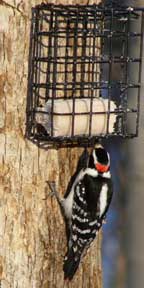 |
Previous Issues |
| Cedar Mill Community Website |
|
| About Cedar Mill News |
|
||||||
| Volume 5, Issue 3 | March
2007 |
|||||
The Nature of Cedar Mill
|
 |
| Downy Woodpeckers occasionally supplement their diet of bugs and berries with tidbits from feeders |
Here in the Tualatin Valley we are lucky to have six regular visitors to our forests and woodlands: Acorn Woodpecker, Downy Woodpecker, Hairy Woodpecker, Red-breasted Sapsucker, Northern Flicker, and the Pileated Woodpecker.
The Acorn Woodpecker is a habitat specialist, typically occupying oak woodlands and forests. This strikingly colored bird is a bit smaller than a robin, averaging 9-11” bill tip to tail tip. It has an all-white rump, a white forehead and throat patch, and bright red cap. It is well known for its habit of stashing acorns in the bark of trees.
The Downy and the Hairy Woodpeckers are very similar in appearance, with size being the most obvious difference. The Downy Woodpecker averages about 7” long and the Hairy Woodpecker averages about 9”. Both live in our local forests, though the Hairy Woodpecker is more commonly seen in mature forests, while the Downy can be seen foraging in shrublands and even visiting suburban feeders. A quick way to remind yourself which you might be observing is to think, “Hairy is huge, Downy is diminutive.” They eat a wide variety of insects, but will also graze on the berries from such native plants as serviceberry and poison-oak.
The Red-breasted Sapsucker is well known for drilling horizontal rows of holes in the trunks of living trees, then returning to drink the sap, and to eat the insects that show up for the sap. They are the size of a small robin and can be easily identified by their all-red heads. They can be found in conifer or mixed conifer-hardwood forests and usually migrate to lower elevations in the Tualatin Valley during winter.
The Northern
Flicker is probably one of the most commonly seen woodpeckers of
the area. They are the second largest of our woodpeckers, averaging
about 12” long.
Two varieties occur in Oregon, but the
Red-shafted Flicker is the common variety in the Tualatin Valley;
the Yellow-shafted Flicker is common to the east and north in Oregon.
Flickers have a distinct white rump patch that flashes as they fly
(thus, the name) and a black chest patch, and the males in our variety
have a red mustache that extends across the cheek. Flickers can be
found foraging for insects on the ground, but they also will eat
a wide variety of nuts and berries.
Our largest woodpecker, the Pileated Woodpecker (pronounced PILL-ee-ay-ted) has recently been in the news as the bird that may be confused with the endangered Ivory-billed Woodpecker of the southeast United States. The Pileated Woodpecker is easily identified by its red, pointed crest (‘pileated’ is from the Latin word for cap). Their long necks and large heads give them a distinctive “prehistoric” look. Pileated Woodpeckers prefer mature woodlands where large, rectangular holes are drilled in snags when they search for their favorite food: carpenter ants. They are regularly observed in Jordan Park.
Cedar Mill Business Association
Published monthly by Cedar Mill Advertising & Design
Publisher/Editor:Virginia Bruce
503-629-5799
12110 NW West Rd
Portland, OR 97229